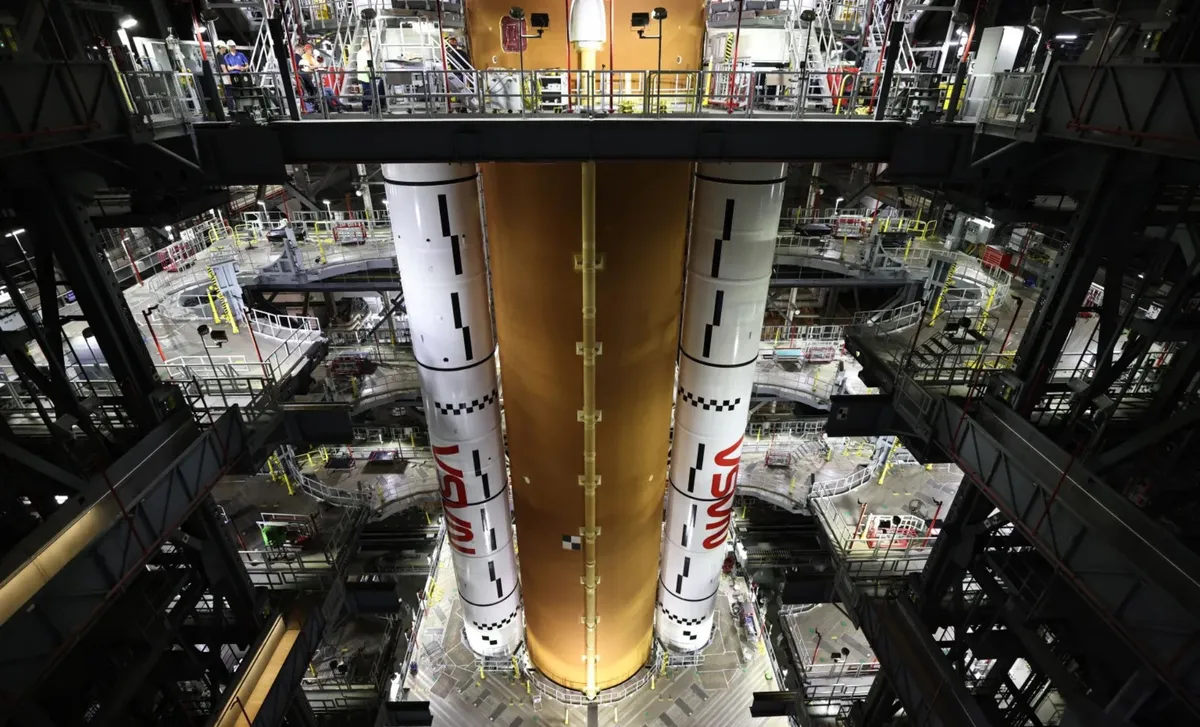
On March 23, 2025, NASA reached a significant milestone for the Artemis II mission with the successful integration of the core stage of the Space Launch System (SLS) rocket at the Kennedy Space Center in Florida. This achievement represents a crucial step toward launching the first crewed mission of NASA’s Artemis program. The successful integration was highlighted in a post by NASA on March 24, 2025, showcasing the steady progress of the Artemis II mission.
The integration process involved bringing together the core stage with the solid rocket boosters, which had already been stacked and secured in the Vehicle Assembly Building. The core stage, towering at 212 feet, is an essential component of the SLS rocket, designed to carry the Orion spacecraft and its crew on a 10-day mission around the Moon as part of Artemis II. This flight is not just a test of the mission’s systems and hardware; it also lays the foundation for NASA’s future deep space exploration missions, which aim to include human missions to both the Moon and Mars.
The core stage of the SLS rocket serves as the backbone of the entire launch system, acting as the central component that supports various mission elements including the launch vehicle stage adapter, interim cryogenic propulsion stage, and the Orion stage adapter. The integration of this critical component is vital for ensuring that all parts of the mission work together seamlessly. Utilizing one of the five overhead cranes in Kennedy’s Vehicle Assembly Building, the team at NASA’s Exploration Ground Systems Program, in collaboration with their primary contractor Amentum, successfully lifted the core stage and positioned it between the solid rocket boosters stacked atop the mobile launcher. This operation demanded precision and expertise, positioning the core stage as the central unit that now holds all other crucial components for the mission.
With the core stage now in place, preparations will continue for the next phase of integration, which includes adding the Orion stage adapter atop the core stage in the upcoming weeks. This step is essential for completing the structure that will support the Orion spacecraft on its journey to the Moon.
Artemis II is particularly significant as it represents the first crewed mission under the Artemis program, which aims to establish sustainable human exploration on the Moon by the mid-2020s and subsequently send astronauts to Mars. This mission will carry four astronauts on a 10-day journey orbiting the Moon, testing the vital hardware and systems necessary for future human missions to the lunar surface. The success of this test flight is critical for confirming the functionality and safety of the entire spacecraft and launch vehicle, laying the groundwork for future lunar landings.
The foundational data collected from Artemis II will be instrumental in ensuring that future human space exploration missions are not only achievable but also sustainable. The SLS rocket and Orion spacecraft are central to NASA’s vision for deep space exploration, and the integration of these critical components marks just one step toward sending astronauts beyond low-Earth orbit. Artemis II will also provide the first opportunities to evaluate human spaceflight performance in deep space, beyond the Earth-Moon system.
Following the successful integration of the core stage, the next steps for the Artemis II mission involve further assembly and integration of remaining components. One of the next significant tasks will be adding the Orion stage adapter to support the Orion spacecraft during its launch. Subsequently, the rocket will undergo a series of tests to ensure all systems are functioning correctly prior to launch.
NASA engineers and ground systems teams will meticulously continue to prepare both the spacecraft and rocket for flight. These preparations will include finalizing the integration of the cryogenic propulsion stage, conducting engine tests, and validating the performance of key systems within the SLS rocket. Once these steps are completed, the Artemis II mission will be poised for launch, marking a monumental leap in humanity’s efforts to return to the Moon and explore beyond.